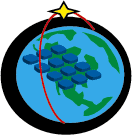Some of the Many Uses of Satellites Today
Michael H. / Physics 336 / 7 April 1997

Sometimes an object you come across can have many different uses for
many different people. The same holds true for satellites. For many different
companies use them for many different purposes and reasons. For instance,
you can use a satellite for communications, observation, and navigation
just to name a few.
Purpose of Unmanned Satellites
Unmanned satellites have six primary functions. First, to investigate
the characteristics of the upper atmosphere as well as the exosphere. Second,
to study the nature of the earth's space including energetic particles,
interplanetary matter, and electromagnetic radiation. Third, to study celestial
objects from a vantage point beyond the atmosphere. Forth, to carry out
biological experiments. Fifth, to perform non-scientific tasks in applied
technology. Such as communications, observation, and navigation. And lastly
they are used in support of manned operations. The functions listed here
are the satellites primary functions, not their only functions.
Communications
One use of satellites is in the field of communications. Communications
is a wide topic. It includes television, phones (cellular as well as others),
the Internet, beepers, etc.. So, how do satellites work in these devices?
Well, lets take television first. By using a satellite dish and a satellite
television network, a satellite can beam down as many as 200 crisp, clear
channels with CD quality sound. The use of satellites with the Internet
would make access faster and cheaper. This would allow consumers to link
their home computers to the Internet. The special two-way satellite connections
promise fiber-optic-like speeds. And now there are plans to combine satellite
television and the Internet into a single dish. On to the phones. The phones
that will use satellites are called Globo-Phones. They are expected to
come as early as 1998. These phones will provide global hand-held wireless
service. Which will provide executives with a cellular-like phone that
they could take anywhere they travel. Recently, the company Motorola has
released a plan consisting of a network of 72 low-orbit satellites to provide
businesses with broad bandwidth communication links around the globe.
Observation
Another use of satellites is in the field of observation. Like communications,
observation is another wide topic because there are many different types
and uses. For instance, one type of observation is espionage or what is
commonly called the "spy" business. Between the years 1960 and
1972, 95 Corona satellites conducted espionage successfully. Another area
would be geology, or the study (observation) of the earth. Satellites are
used by the United States Geological Survey to take extensive photographs
of the country. Satellites also allow geologists to make long-duration
measurements over many different latitudes and longitudes. They (geologists)
also use satellites to monitor natural phenomena, such as clouds, glaciers,
sea ice, deserts, and tropical rain forests. The geologists use this information
gathered by the satellites to collect clues about long-term global climatic
change and ecological threats.
Navigation
A third use of satellites is in the field of navigation. Like communications
and observations, navigation is a large topic because of the many different
kinds of transportation. One form of transportation is via automobile or
car. The automobile satellite navigation system, called the Guidstar Global
Positioning Satellite (GPS) system. This system keeps an eye on you by
taking signals from four satellites to triangulate (a process to determine
where you are) your position. Next it compares the information from the
satellites with directional signals from a car-mounted gyroscope and the
odometer. Then it plots all the information gathered against a map encoded
on a computer disk in the trunk. Under the automobile category, the National
Highway Safety Administration announced a two-year study of an in-vehicle
unit that would log on to the Defense Department's 24 global positioning
satellites and automatically alert emergency medical services and give
then the place and location when a severe accident occurs. The system would
be able to differentiate between a fender-bender and a serious accident.
Another area would be aerial transportation. In this area satellites are
used with the landing systems. One type is the microwave landing system,
which uses microwave signals to help land the plane. However, this type
of landing system is expensive. Another type of landing system uses the
global positioning satellite system. This system is used in poor visibility
landings and is inexpensive. The microwave and GPS systems are expected
to replace ground based navigational systems.
Conclusion
Satellites have many different uses and purposes for many different
people. They are used in the fields of communications, in the areas of
television, the Internet, and phones; observation, in the areas of espionage,
and geology; and navigation, in the area of transportation as well as many
topics and sub-topics.
WORKS CITED
Anselmo, Joseph C. "Motorola Unveils New Satcom Plan." Aviation
Week and Space Technology. 16 Sept. 1996: 35.
Brood, William J. "Spy Satellites' Early Role as 'Floodlight'
Coming Clear." The New York Times. 27 Nov. 1995: Online.
America Online. 31 Dec. 1996.
---, "U.S. Satellites Used on Nature Missions." The New
York Times. 27 Nov. 1995: Online. America Online. 31 Dec. 1996.
Evarts, Eric C. "For the Directionally Challenged, a Satellite
to Keep the Car on Course." Christian Science Monitor. 23 May
1996, 13. Online. America Online. 31 Dec. 1996.
Langreth, Robert. "Fail-Safe Skies: Coming into the 21st Century?."
Popular Science. Jan. 1993: 76+. SIRS Researcher.
CD-ROM. SIRS, Winter 1996.
Nikkel, Cathy. "Satellite Guardian Angels of the Highway."
Motor Trend. Mar. 1996: 34
Ordway III, Frederick I. "Satellite, Artificial." The
Encyclopedia Americana International Edition. Connecticut: Grolier
Incorporated, 1995. 287, 292-293.
Shine, Eric, et al. "The Satellite Biz Blasts Off." Business
Week. 27 Jan. 1997: 62-66, 68, 70.